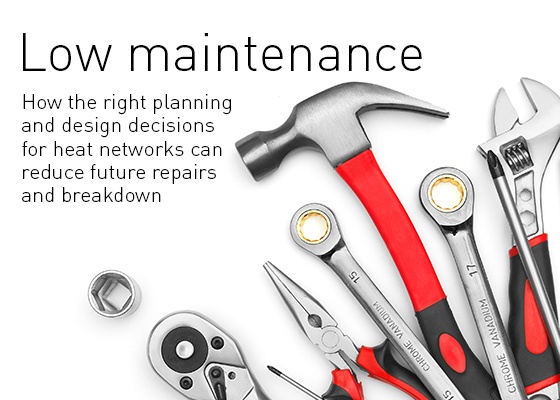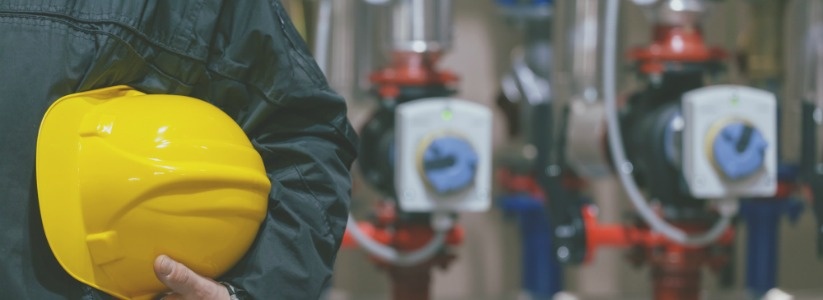The pipes may be gleaming now but, when it is up and running, your heat network will be under stress. That’s why future maintenance should be a key consideration in the early planning stages.
 Heat networks are high capital cost assets, requiring a long period to provide a good return on investment. But long life means keeping maintenance costs as low as possible, and every system needs to be designed with this in mind. Reliability and low maintenance costs and high reliability are essential for customer satisfaction.
Heat networks are high capital cost assets, requiring a long period to provide a good return on investment. But long life means keeping maintenance costs as low as possible, and every system needs to be designed with this in mind. Reliability and low maintenance costs and high reliability are essential for customer satisfaction.
Maintenance costs need to be considered at feasibility stage, and the ADE CIBSE Heat Networks Code of Best Practice recommends estimating them based on actual costs from a similar operating plant. A long-term repair and replacement strategy should be developed to ensure that the true long-term costs are fully taken into account.
Maintenance plans
Heat Trust guidelines say a developer should ensure that its community heating scheme is maintained to perform within guaranteed standards. To ensure this, contingency and maintenance plans need to be put together early on, setting out action to be taken regularly or in emergencies.
Plans should also outline the regular maintenance required for reliable heat production, control, transportation and metering, including appropriate monitoring and reporting of central plant and building connections, in order to pick up issues before they become problems.
The maintenance plan should, above all, minimise health and safety risks to staff, customers and the general public. It is important to get this right as emergencies resulting from a flood, fire or electrical failure could involve injury or serious damage to property. Emergency calls should to be answered 24 hours a day, seven days a week via telephone, and not by an automated system.
Customer involvement
As maintenance or breakdown can involve the shutdown of systems or require access to customers’ property, each customer needs to be informed of any obligations they may have, and provided with a copy of the maintenance and contingency plan. Emergency and access arrangements should be included, where possible, in each customer's heat supply agreement, to ensure inspection and maintenance activities can be undertaken.
Design, materials and installation
Maintenance will also be influenced by system design and materials, so both should be chosen carefully with reliability and durability in mind. Design needs to ensure an optimum operating environment for the community heating system. If not, additional wear and tear may result from the system working outside its normal parameters, pushing up maintenance costs and causing more frequent breakdowns. Developers should also ensure the design allows ease of access to areas requiring maintenance or periodic replacement.
An important point to add is a recent trend we have seen to oversize plant. There may be valid reasons for this, but heat providers need to bear in mind that this will lead to higher maintenance costs.
When it comes to installing the various parts of the heating system, the manufacturer’s installation guidelines should be followed carefully to ensure the quality and low maintenance of the system.
Once installation is complete, testing and commissioning is required to make sure the system is free from latent defects and performs to specification. This should follow the Heating and Hot Water Industry Council’s “Benchmark - Heat Interface Unit Commissioning Checklist”, developed by representatives from across the industry.
Good commissioning will help deliver an efficient and reliable service, which can be assured by employing independent commissioning experts. It is important for inspection and sign off to take place before parts are sealed in floors and walls, or buried in the ground.
For a further guarantee against unexpected maintenance costs, the system installer may be willing to offer an extended warranty on the materials - and possibly installation of the system - for up to 20 years. This needs to be established early at the time of tender, including whether these are underwritten through an insurance scheme.
Takeaways:
- Reliability is essential for customer satisfaction
- Use experience from similar plants to help estimate maintenance costs
- Draw up and communicate clear maintenance and contingency plans
- Prioritise safety and keep customers aware of any obligations
- Use system design and materials to minimise maintenance requirements, and look for extended warranties where possible.
- Ensure careful independently-verified commissioning to identify any problems



